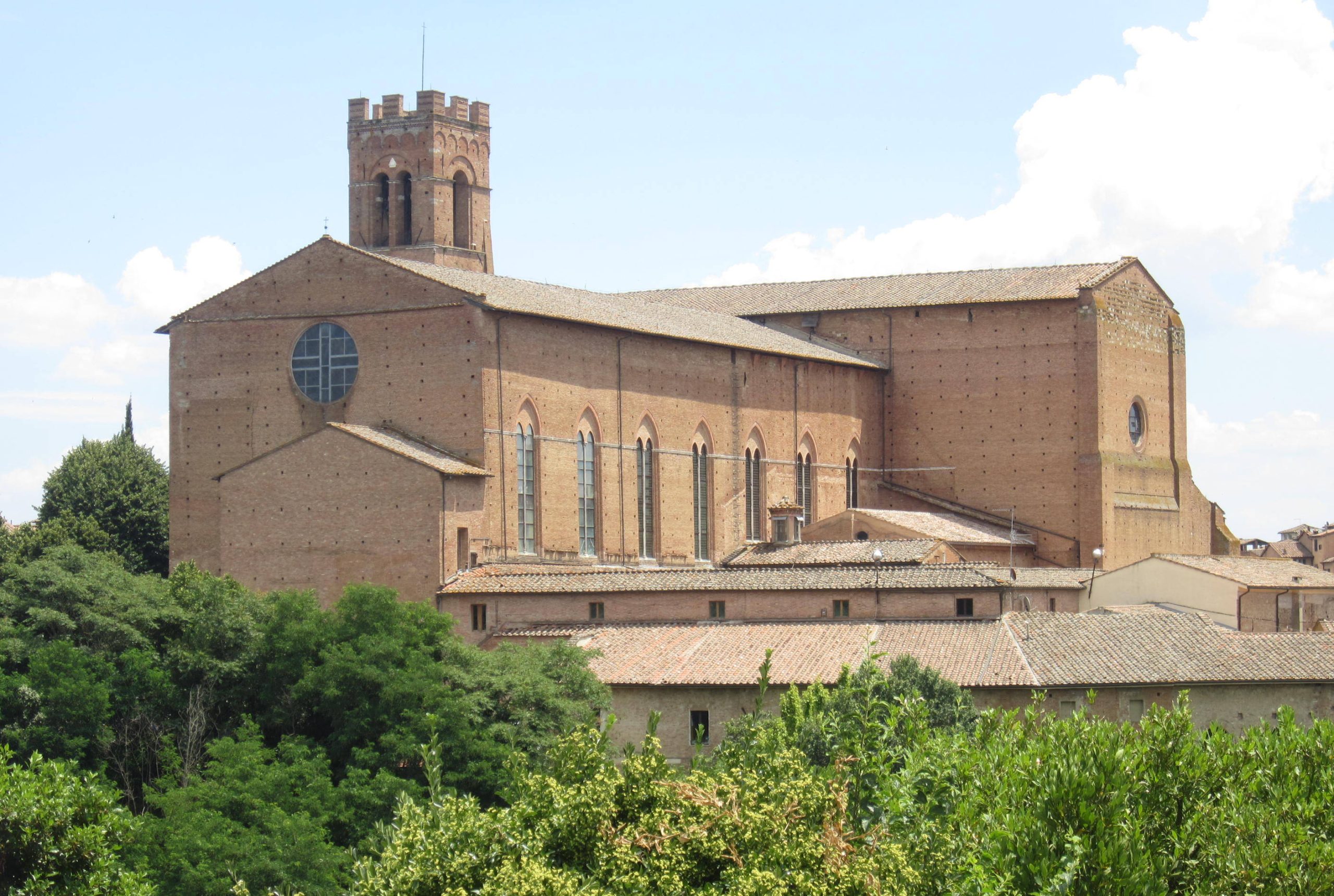8.8 The Hidden Treasures of Lay Confraternities
Brothers in Faith
Although it is very difficult to trace the exact origins of the Confraternities or Lay Companies, it is certainly accurate to say that their history is intrinsically linked to that of the Church itself. Gathering together in associations was a need felt by Christians from the very beginning in order to transform the love and brotherhood preached by Christ into concrete works.
The Confraternities we know today were born in the 12th century and were made up of groups of lay faithful who, unlike religious congregations, did not take vows or live in communities. The foundation of a Confraternity was granted by a decree issued by the ecclesiastical authority and by the adoption of a statute that established its aims and regulated its internal social relations. The Confraternity’s aim was missionary, i.e. to increase public worship and to perform works of charity such as caring for the sick and prisoners, welcoming pilgrims, burying the dead, and building hospitals. All this was made possible thanks to the contributions of the members themselves, the donations of private individuals, bequests, and income from the properties they owned. 
Over the centuries, the presence of Confraternities encompassed a large part of Europe. With their widespread diffusion throughout all social classes, Confraternities were instrumental in saving the Church during the years of spreading heretical beliefs. Moreover, many contributed to the social, artistic, and economic development of the cities in which they operated by building hospitals, ‘ospizi’ (hospices—places where travellers could rest and be taken care of by their hosts) for pilgrims and the poor, orphanages and conservatories for girls, churches, oratories, and monuments. They made a remarkable contribution to the development of the arts, commissioning music, sculptures, paintings, and religious works for their premises.
Despite the suppressions during the Napoleonic era, many Confraternities were re-established and still continue to be part of the ecclesiastical structure with the task of teaching Christian doctrine and increasing public worship, participating in the active life of the Church, and bearing authentic witness to faith and charity.
CONFRATERNITA DI SANTA CATERINA DELLA NOTTE
Initially named after Saint Michael the Archangel, the Confraternity was based in the Spedale di Santa Maria della Scala, one of the oldest hospitals in Europe, so called because of its location in front of the steps of the Cathedral of Siena. Founded in the 9th century by the canons of the cathedral as an expression of God’s love for the needy, this pious institution was first and foremost a hospice for the many pilgrims passing along the Via Francigena, as well as a refuge for abandoned children and the poor seeking alms. Over the course of time, in addition to these purposes, treatment and care of the sick was added. 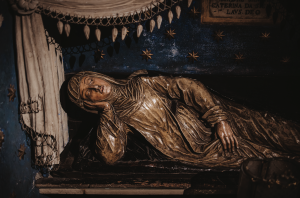 The ancient Compagnia di San Michele Arcangelo (Company of St Michael the Archangel) was mainly dedicated to caring for the sick and offering up piety to the dead, and it is no coincidence that it had its headquarters in the premises of the hospital near the so-called ‘carnaio’, a cemetery with a cavity where corpses were buried and which can still be seen today; St Michael the Archangel himself is the ‘psychopomp’ saint, i.e. he who accompanies the souls of the dead into the afterlife. Gradually, a part of these premises was transformed into a proper oratory, where the brethren would pause in prayer and meet to discuss the reasons for their service. Even St Catherine of Siena, naturally drawn to a place like Santa Maria della Scala, where faith was expressed in love of neighbour, would go there every day to provide assistance and comfort to the needy. During the long nights spent at the bedside of the sick, it was in the Company’s oratory that she would stop to pray and seek rest, retiring to the little cell that still exists on the left side of the hall. Although Catherine had never belonged to the Confraternity, the members of which were exclusively men, the name of the Company was changed to Santa Caterina della Notte (Saint Catherine of the Night) in her honour and as a tribute to her ties with the brothers and their beloved place, as evidenced by documents dating back to 1479.
The ancient Compagnia di San Michele Arcangelo (Company of St Michael the Archangel) was mainly dedicated to caring for the sick and offering up piety to the dead, and it is no coincidence that it had its headquarters in the premises of the hospital near the so-called ‘carnaio’, a cemetery with a cavity where corpses were buried and which can still be seen today; St Michael the Archangel himself is the ‘psychopomp’ saint, i.e. he who accompanies the souls of the dead into the afterlife. Gradually, a part of these premises was transformed into a proper oratory, where the brethren would pause in prayer and meet to discuss the reasons for their service. Even St Catherine of Siena, naturally drawn to a place like Santa Maria della Scala, where faith was expressed in love of neighbour, would go there every day to provide assistance and comfort to the needy. During the long nights spent at the bedside of the sick, it was in the Company’s oratory that she would stop to pray and seek rest, retiring to the little cell that still exists on the left side of the hall. Although Catherine had never belonged to the Confraternity, the members of which were exclusively men, the name of the Company was changed to Santa Caterina della Notte (Saint Catherine of the Night) in her honour and as a tribute to her ties with the brothers and their beloved place, as evidenced by documents dating back to 1479.
The oratory is an evocative environment and its appearance reflects the typical characteristics of a confraternal oratory: a single nave with wooden stalls on the lower part of all the walls—except for the back wall which was reserved for the altar—where the brothers sat during meetings; those against the entrance wall were generally reserved for the members who governed the Company. The space is divided into three bays and has a vaulted ceiling characterised by late-17th century stucco decoration, which becomes increasingly more lavish near the altar. It frames a heterogeneous series of paintings by mostly unknown artists, some of which are panels and the others canvases, in some cases fragments of lost works, dating from between the 16th and 18th centuries; they depict episodes from the life of Christ, the Virgin, and Saint Catherine. 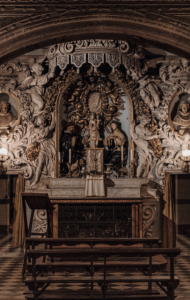 The back wall is occupied by the high altar, where, under a canopy supported by four angels, between the sculptures of St Dominic and St Catherine, rests a small marble Madonna e Bambino (Madonna and Child), a work of Nordic origin dating from the late 14th century, which is perhaps the oldest cultic image of the Company. Lastly, in the room adjacent to the sacristy, there is a beautiful gold-ground triptych by Taddeo di Bartolo depicting the Madonna con Bambino e i Santi Giovanni Battista e Andrea (Madonna with Child and Saints John the Baptist and Andrew), dated 1400. On either side hang four headboards of a ‘catalètto’ – the stretcher used to carry the dead, which depict Santa Caterina che Protegge Sotto il Manto Quattro Confratelli (Saint Catherine Protecting Four Brothers Under Her Mantle, the Stimmate della Santa (Stigmata of the Saint), the Deposizione (Deposition), and the Resurrezione di Gesù Cristo (Resurrection of Jesus Christ), attributable to a Sienese artist from the early decades of the 16th century, most likely Giacomo Pacchiarotti.
The back wall is occupied by the high altar, where, under a canopy supported by four angels, between the sculptures of St Dominic and St Catherine, rests a small marble Madonna e Bambino (Madonna and Child), a work of Nordic origin dating from the late 14th century, which is perhaps the oldest cultic image of the Company. Lastly, in the room adjacent to the sacristy, there is a beautiful gold-ground triptych by Taddeo di Bartolo depicting the Madonna con Bambino e i Santi Giovanni Battista e Andrea (Madonna with Child and Saints John the Baptist and Andrew), dated 1400. On either side hang four headboards of a ‘catalètto’ – the stretcher used to carry the dead, which depict Santa Caterina che Protegge Sotto il Manto Quattro Confratelli (Saint Catherine Protecting Four Brothers Under Her Mantle, the Stimmate della Santa (Stigmata of the Saint), the Deposizione (Deposition), and the Resurrezione di Gesù Cristo (Resurrection of Jesus Christ), attributable to a Sienese artist from the early decades of the 16th century, most likely Giacomo Pacchiarotti.
CONFRATERNITA DEI DISCIPLINATI
In addition to the Campagnia di Santa Caterina della Notte, the other important confraternity that had its seat in the cellars of the Spedale was the Compagnia dei Disciplinati (Company of the Disciplined), so called because of the use of the flagellum, also known as a discipline, as an instrument of physical self-expiation. The very adoption of an emblem with a cross and two disciplines hanging from it indicated the brothers’ adherence to Christ’s sacrifice and to the penance of the flagellants.
The Confraternity was most likely formed during the 13th century, the period in which the first statutes were issued, but its legendary origins date back to the early Middle Ages, if not even further back to the time of Saint Ansanus, baptist and patron saint of Siena, martyred, according to tradition, in the nearby Strada del Fosso, which is still dedicated to him. The rules of the statute that dictated the requirements for admission to and membership in the Compagnia called for a rigorous screening of citizens who aspired to join, chosen from among the most authoritative representatives of the Sienese ruling class, on whom an austere lifestyle was imposed through strict and meticulous rules, but who were also recognized as fulfilling a prestigious role as political advisors and managers of public charity. In the 13th and 14th centuries, the Company counted among its affiliates leading figures of Sienese mysticism such as Saint Bernardo Tolomei and the Blesseds Andrea Gallerani, Pietro Petroni, and Giovanni Colombini, as well as a group of disciples of St Catherine. At the beginning of the 15th century, before entering the Franciscan order, the young St Bernardine of Siena also belonged to the Company, developing his vocation by helping the plague victims in the Spedale.
In the age of the Counter-Reformation, the Confraternity was a centre of worship officiated frequently and regularly by five chaplains, one for each of the oratory’s altars, while the brothers distinguished themselves for their charitable work on behalf of the indigent, prisoners, and the most deprived pious areas. Its assets also grew as a result of the numerous donations and bequests for the salvation of souls that were made between the 16th and 18th centuries by various members of the Sienese aristocracy, to the point that when the decision was taken in 1783 to introduce an additional tax levy to help with the reformation of the University of Siena, the Company was taxed as the richest institution by far among those of the time. Two years later, the suppression of the lay confraternities in Tuscany decreed by the grand-ducal government spared the property of the Compagnia, which was secularized and transformed into the ‘Società di Esecutori di Pie Disposizioni’ (Society of Executors of Pious Dispositions), the institution that, for more than two centuries, has continued to perform important socio-economic functions in Siena and the surrounding territory of the former state.
The numerous premises of the Society, located a short distance from the Oratory of the Compagnia di Santa Caterina della Notte, contain a remarkable historical and artistic heritage that has increased in recent years with the discovery of an interesting cycle of early 14th-century frescoes representing the Tebaide (Thebaid), which was discovered along the stairway leading to the Society’s headquarters. Among the other works, there is a beautiful wooden crucifix on the left-hand altar of the Oratory, which, according to legend, induced St Bernardine to don the Franciscan habit.
CONFRATERNITY OF SANTA MARIA IN PORTICO IN FONTEGIUSTA
The origins of the Confraternity are closely linked to those of the Società Minore della Vergine Maria (Minor Society of the Virgin Mary), founded by Blessed Francesco Patrizi of Siena in 1298. A few decades later, in 1334, a sort of split occurred within the Confraternity when some of the brethren decided to change its name, renaming it the Compagnia alla Santissima Trinità (Company of the Holy Trinity), the feast day of which had been introduced into the liturgical calendar of the Roman Church that very year by Pope John XXII.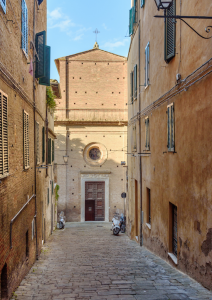
Other members wished to maintain the original name dedicated to the Virgin and moved their seat to Camollia, to a small oratory dedicated to San Sebastiano (St Sebastian), near the ancient Porta di Pescaia, also known as Fontegiusta (from the Latin iuxta fontem, ‘near the fount’) since it was located near one of the many medieval fountains that supplied water to the city but which no longer exists. The gate was equipped with a portico for collecting duties in which there was a 14th-century fresco attributed to Lippo Vanni depicting the Madonna con il Bambino fra i Santi Paolo (o Andrea) e Bartolomeo (Madonna and Child with Saints Paul or Andrew and Bartholomew), a not uncommon presence since the Government of Siena, after the Battle of Montaperti, had decided, in deferential homage to the Madonna, that Marian images should be painted on the numerous gates of the city to protect its walls.
The cult of the image of Fontegiusta began, however, in 1434, when a Florentine exile, having survived the wounds sustained in an attack near the gate, believed he had been saved thanks to the intercession of that image of the Madonna, which gradually became an object of great devotion. In 1478, a fundamental year for the Company, it obtained official recognition from Pope Sixtus IV and, at the same time, approval to build its own oratory, the construction of which had already been started by the brothers in order to protect and guard the sacred fresco. Moreover, on 7 September of the following year, the Sienese army won against the Florentine army in the Battle of Poggio Imperiale, and on the following day, the Feast of the Nativity of Mary, the arms and standards taken from the enemy were offered to the Madonna of Fontegiusta, with the participation of a large number of the population. Thus, in 1482, at the behest of the city’s Consiglio Generale and as a sign of gratitude to the Virgin, work began to enlarge the oratory, which was completed a few years later, giving rise to one of Siena’s most important Marian shrines.
Built close to the walls, incorporating the portico with the miraculous image—from which the name of the Company itself derives—the building, devoid of an apse, has a square floor plan with three naves reduced in length, precisely due to the little space available between the façade and the walls themselves. The exterior has a brick façade and a Renaissance marble portal, while the interior is marked by columns supporting cross vaults. The focal point of the church is the high altar with its fresco of the Virgin Mary; the two figures of saints that originally flanked it were removed some time ago and are now kept in the nearby hall, where a small collection of objects belonging to the Company has been set up. The sacred image is embellished and highlighted by the most artistically important work preserved inside the church: the magnificent tabernacle in the form of a small temple sculpted between 1509 and 1517 by Lorenzo di Mariano, known as Il Marrina, a refined masterpiece of sculptural art. In the lunette above is a fresco depicting the Assunzione della Vergine (Assumption of the Virgin), painted in 1515 by Girolamo di Benvenuto, while on the sides are the Natività di Maria (Birth of Mary), the Annunciazione (Annunciation), and the Dormitio Virginis (Dormition of the Mother of God), 17th-century additions by Ventura Salimbeni. Like these, many of the other works that make up the rich artistic collection of the church, most of which date back to the 16th century, feature the Madonna as their subject and bear witness once again to the deep bond that connects not only this Company but the city of Siena itself to its patroness.
Suppressed in 1785, the Confraternity was re-established in 1792 and merged with that of Blessed Ambrogio Sansedoni, which had its headquarters in the Basilica of San Domenico, thus giving rise to the current title of Venerabile Compagnia di Santa Maria in Portico a Fontegiusta e del Beato Ambrogio Sansedoni (Venerable Company of Santa Maria in Portico at Fontegiusta and of Blessed Ambrogio Sansedoni).
CONFRATERNITA DELLA SANTISSIMA TRINITA’
Like the Compagnia di Fontegiusta, it grew out of the Società Minore della Vergine Maria, founded in 1298 at the Basilica dei Servi by the Blessed Francesco Patrizi of Siena. Some time after the founder’s death, in 1334 to be precise, some of its members established the Confraternità della Santissima Trinità (Confraternity of the Holy Trinity), in honour of the feast that Pope John XXII had included that year in the liturgical calendar of the Roman Church for the very first time.
Over the following centuries, the Company was characterized by considerable drive and vitality, so much so that by about the mid-16th century it had become the first of the Sienese Confraternities—all of which had been reserved for men only up to that time—to decide to create an association of women within it. With the 1785 edict of the Grand Duke of Tuscany, the Confraternity was suppressed, only to be re-established five years later, following the persistent requests of the Archbishop of Siena Monsignor Tiberio Borghesi. However, as happened to most of these institutions, the loss of property and the constant political changes following the French Revolution led to an inexorable decline. After the events of the Second World War, the Confraternity came back to life and, in the 1970s, its oratory was granted to the Contrada of Valdimontone for permanent use.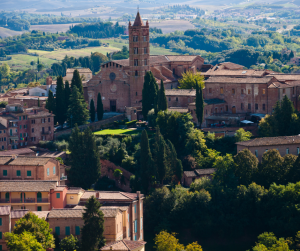 Later, in 1993, it adopted a new charter, becoming a Congregazione Generale (General Congregation), until the new Chapter was approved in 1998. The Oratory of the Santissima Trinità, adjacent to the apsidal part of the Basilica dei Servi, had presumably been in existence since 1380, but it was only at the end of the 16th century that, in spite of serious economic difficulties, the brothers decided to renovate and decorate the entire church with frescoes and stucco work, creating a rich but harmonious environment, a splendid example of Mannerism. The work continued for over a century and featured the participation of artists and master craftspeople, both from Siena and elsewhere, who gave life to a surprising space in which architecture, sculpture, and painting come together to create a unified whole. The paintings, by such artists as Ventura Salimbeni, Raffaello Vanni, and Giuseppe Nasini, present a wide variety of subjects, united by an iconographic plan with a single underlying idea: the demonstration of the victory of faith over heresy, a spiritual restlessness that hovered over civil society at the end of the 16th and beginning of the 17th centuries, especially among the lower classes, who were more reluctant to accept the truths of faith in dogmatic terms.
Later, in 1993, it adopted a new charter, becoming a Congregazione Generale (General Congregation), until the new Chapter was approved in 1998. The Oratory of the Santissima Trinità, adjacent to the apsidal part of the Basilica dei Servi, had presumably been in existence since 1380, but it was only at the end of the 16th century that, in spite of serious economic difficulties, the brothers decided to renovate and decorate the entire church with frescoes and stucco work, creating a rich but harmonious environment, a splendid example of Mannerism. The work continued for over a century and featured the participation of artists and master craftspeople, both from Siena and elsewhere, who gave life to a surprising space in which architecture, sculpture, and painting come together to create a unified whole. The paintings, by such artists as Ventura Salimbeni, Raffaello Vanni, and Giuseppe Nasini, present a wide variety of subjects, united by an iconographic plan with a single underlying idea: the demonstration of the victory of faith over heresy, a spiritual restlessness that hovered over civil society at the end of the 16th and beginning of the 17th centuries, especially among the lower classes, who were more reluctant to accept the truths of faith in dogmatic terms.
CONFRATERNITA DEI SANTI NICCOLO’ E LUCIA
Initially established in the Church of the Carmine, the Company was founded towards the end of the 12th century under the name of San Niccolò. In 1398, the members moved their headquarters to the rooms annexed to the nearby Church of Santa Lucia, which were used at the time as accommodation for pilgrims and the needy, allowing the brothers to exercise the charity and concern for others that have always guided these pious institutions. The small shelter remained in use and was managed by the Confraternity until 1574, when it was suppressed by Francis I. Restored almost two centuries later, it was converted into a convalescent home for the patients of the Spedale di Santa Maria della Scala, but only for a short time. With the suppressions of Pietro Leopoldo (Leopold II), the Company was suppressed and the premises sold. The church remained, and after some time the Confraternity was re-established and has remained in existence to this day.
Of medieval origin, the Church of Santi Niccolò and Lucia was completely rebuilt between the late 16th and early 17th centuries. The façade, in Renaissance style, is plastered and surmounted by a tympanum, with brick pilasters and cornices. The interior, properly Baroque, is divided into a single room with three altars and presents a very rich decorative scheme, consisting of mainly 17th-century stucco work and frescoes by Sienese artists. Sebastiano Folli is responsible for the large scene in the vault depicting the Trionfo di Santa Lucia (Triumph of Saint Lucy), while in the lunettes on the sides of the nave a pupil of Astolfo Petrazzi painted episodes from the lives of the Saint Lucy and Saint Nicholas. The patron saints of the church are also represented in the two beautiful polychrome terracotta statues attributed to Giacomo Cozzarelli or Giovanni di Stefano and placed in an elevated position on either side of the presbytery arch, while on the high altar is the altarpiece depicting the Martirio di Santa Lucia (Martyrdom of St Lucy), painted by Francesco Vanni in 1606.
Every year on 13 December, the Feast of Saint Lucy, the church becomes the centre of a tradition dear to the hearts of the Sienese, who flock there to receive a blessing of the eyes and to light a candle to the saint, the root of whose name bears the word ‘luce’ (light).
CONFRATERNITY OF SAN BERNARDINO AL PRATO DI CAMOLLIA
The Confraternity originated from the Lay Company named after Saint Bernardine, established in 1590 at the Convento dell’Osservanza, founded by the Sienese saint at the beginning of the 15th century on Colle della Capriola, just outside Siena. Here, the Company had some rooms and a chapel for religious functions, devoting itself to works of charity and the burial of the dead. Towards the end of the 17th century, the complete renovation of the convent complex led to the elimination of the rooms used by the brothers, who were forced to look for a new location. The church at the Antiporto di Camollia was chosen, on the site where a monastery of Cistercian nuns had once stood. Suppressed in 1393, it was transformed into a hospital for pilgrims in the following century, which was then granted by the Bishop of Siena to the Canonici Regulari di Sant’Antonio of Vienna, who cared for the sick until the mid-16th century, when the hospital was destroyed by fire.
More than a century later, the church, dedicated to Sant’Antonio di Vienna (St Anthony of Vienna) and having survived the troubled vicissitudes of the complex, was officially entrusted to the Compagnia di San Bernardino (Company of St Bernardine) by decree of the bishop in 1686, later approved definitively by the Congregazione Cardinalizia Romana dei Vescovi e dei Regolari (Roman Cardinal Congregation of Bishops and Regulars) in 1688.
Since then, except for a brief interlude caused by the Leopoldine suppressions, the Confraternity has continued to operate in this location, and the oratory has assumed the name of San Bernardino al Prato di Camollia.
The building has undergone numerous restorations over the course of time, and its current appearance is the result of the 1926 intervention in which the Baroque altars were dismantled. Externally, it has a gabled profile with brick facing and a bell gable; above the entrance portal is a fresco with the image of St Bernardine, a 20th-century work by the painter Otello Chiti. The interior consists of a single nave with a rectangular layout and a presbytery separated by a large round arch. On the high altar is the oldest evidence of the Compagnia’s artistic heritage: the beautiful polyptych by Paolo di Giovanni Fei depicting the Madonna col Bambino e Santi (Madonna and Child with Saints), which dates back to around 1380.
